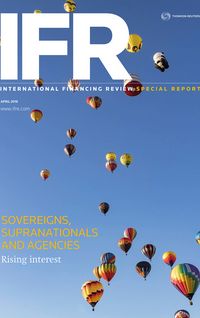SSA issuers may look to front-load issuance in 2018 but the effects of QE will be felt long after it has finished, reducing the likelihood of a taper tantrum.
Later this year, the European Central Bank will fall into line with the US Federal Reserve in ending its programme of quantitative easing, the massive injection of liquidity introduced in 2012 as ECB president Mario Draghi pledged to do ”whatever it takes” to overcome the eurozone crisis.
Now, after purchasing €2trn in public sector debt over the last three years, the ECB is scaling back its bond buying programme. While opinions vary about the precise timing of the withdrawal, the consensus is that it will call time on the programme in December.
Following a meeting last October, the ECB announced it would start reducing PSPP purchases by €30bn a month starting in January 2018, spurred by a buoyant economic outlook across the eurozone.
“We are in this tapering zone now and our own strategy view is that ECB net purchases are likely to end in December and be limited to private sector assets in Q4 2018. We think the ECB is going to end the extraordinary measures pretty quickly and therefore we think this tapering is going to proceed at quite a pace,” said Philip Brown, head of public sector debt capital markets at Citigroup.
The ECB is fortunate in having a precedent to follow. At the end of last year, the US Federal Reserve began reducing its balance sheet, but while the Fed allowed maturities to roll off without re-investment, in Europe, the beneficial effects of QE will continue to be felt in years to come thanks to its carefully orchestrated reinvestment programme .
“By the end of the year (2018), when we think the net purchases stop, the ECB communication would have shifted from its current promise to buy until it works to a commitment to continue reinvestment far into the future and proceed very carefully with the normalisation in policy rates,” said analysts at Bank of America Merrill Lynch in a note to clients on March 7.
The end of QE in the US, where the Fed raised rates three times in 2017, was overtaken by fears of faster-than-expected rate tightening to curb inflation, and that ushered in volatility across the globe. While monetary policy is now converging, Europe remains some way behind the US.
At the moment, bankers and issuers are adopting a sanguine tone to the ending of QE.
“QE tapering is not really news that we are hanging all our hats on at the moment and the thing that we fear most,” said Brown.
Reinvestment of the proceeds from maturing investments is a big factor here. According to asset purchase programme data released in January, reinvestments the first quarter of 2018 were expected to be around €15bn, rising to €40bn in the second quarter, €23bn in Q3 and €38bn in Q4. These totals are likely to increase further during 2019 to around €15bn–€20bn per month next year. Given that the QE programme started in 2015, it is logical that reinvestments will continue long into the future, offsetting much of the effect of tapering.
The big fear is that the withdrawal of QE will spark a risk-off attitude among investors, who will start to look again at underlying fundamentals, which could spark a widening in sovereign spreads among peripheral borrowers.
But the ECB’s reinvestment plan, along with other technical factors and a healthy economic outlook, suggest that the end of QE may not prove to be a traumatic event.
Show of strength
“The structural reform programmes have worked well. Europe is no longer the problem child of the world from an economic perspective. On the contrary, we’ve been through our crisis and Europe is set to outperform in global terms from a number of perspectives,” said Brown.
QE led to a big compression in spreads between core and periphery markets and the improving economic backdrop has led to positive action by ratings agencies. Spain was upgraded and Portugal is now investment-grade. Markets have also recovered from political events, such as the independence vote from Catalonia and the hung parliament in Italy – an event that many predicted would lead to a widening in spreads.
A strong economic outlook in the periphery should ensure that spread compression continues, while there are also strong technical factors at play here.
“Investors seek yield and spread performance in an interest rate-rising environment and have a far greater interest in the periphery markets than they’ve had previously,” said Brown.
With a rate rise likely to result in negative returns in core bond market indices, and with peripheral countries being upgraded, bankers predict a move by core market investors towards the periphery. There is already some evidence of this. On January 23, the Kingdom of Spain printed a €10bn long 10-year deal and it was lapped up by foreign investors.
“With Spain’s syndications this year we’ve seen greater demand for Spanish bonds from Germany than we’ve seen from Spanish investors. Spain is now the highest yielding credit in the euro market and we’re seeing enormous flow out of core markets into the periphery, and that is outweighing any political concerns,” said one banker close to the deal.
”Rather, it is driven by expectations that in a rate-rising environment Bunds are going to underperform more than peripheral government bonds and, because of this, there is room for further potential spread compression between the core and the periphery.”
Spain’s print followed the successful issuance of a 20-year by Italy and a 10-year by Portugal.
Natural rebalancing
Bankers are working on an assumption that as QE is withdrawn, there will be a natural rebalancing as private sector investors take up the slack. For the number of years that QE has been in place, the ECB has been taking a large volume of bonds out of real money investor portfolios and as a consequence real money investors are structurally short.
Brown added: “Many asset managers, insurance companies, bank treasuries, pension funds entered 2018 underweight simply because of the volume of bonds they’ve sold into the QE bid in previous years. I think there is an enormous real money support to rebalance portfolios and to buy the market. So, we’re not seeing any fear. I think the QE unwind is pretty orderly so far.”
SSA borrowers tend to front-load their funding plans to gain breathing space in case market conditions deteriorate, so from an issuer perspective the withdrawal of QE could exacerbate this approach. Borrow when you can, not when you have to, has long been a common refrain in the bond markets.
It will have a more dramatic impact on credit markets, where tapering is less pronounced.
“The ECB has been buying 50% of European credit issuance, which has had an enormously compressing impact,” said one SSA banker. ”We came into 2018 where volatility had been incredibly suppressed by global QE and I think we have seen that volatility is back. But I think that volatility is going to manifest itself in credit markets more than it is in SSA markets.”
Besides, the scale of PSPP meant that the ECB had little choice but to taper – estimates said the available stock of Bunds would run out by the summer until the ECB put the brakes on.
Bund yields responded to expectations of rate rises quickly, rising from 50bp to 75bp in a short space of time. But since the second half of February, there has been a constant rally in 10-year Bunds.
“We are not seeing great signs of inflation, and coupled with fears of trade wars, we’re seeing a bit of a flight to quality. In general, SSA issuers are not really yield-pickers and I don’t think there is any expectation that demand is going to go away any time soon from this sector,” said the SSA banker, adding that much of Feburary’s rally was driven by ECB purchases based on reinvestment flows.
Added to that, most of the tapering will take place in government bonds and the rest of the SSA sector is still very well supported by QE. Buying in that world will continue without the same degree of tapering that will be seen in government bond markets, reckon some bankers.
Brown said: “One of the complications at the end of last year was the dislocations of markets and the challenge of looking for relative value trading opportunities from real money, rather than technical-driven markets. Broadly speaking, real money investors welcome a normalisation of the SSA secondary market where relative value trading considerations will come back.”
QE has run its course, and with uncertainty in China and the US, global portfolios are looking ot increase their exposure to Europe.
“A lot people are starting to have a bigger concern about wanting the monetary authority having the room to adapt to the next crisis when it comes, so I don’t think there’s anyone out there who feels we need these extraordinary stimulus measures any more,” said one SSA banker.
To see the digital version of this roundtable, please click here
To purchase printed copies or a PDF of this report, please email gloria.balbastro@tr.com



